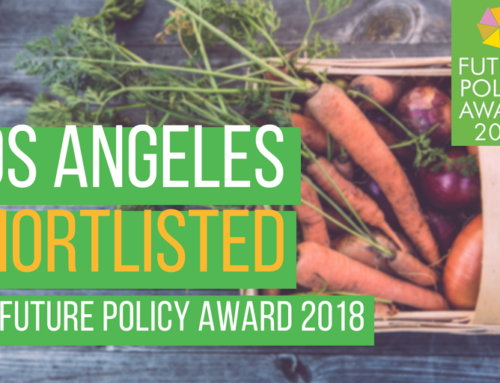“…no famine has ever taken place in the history of the world in a functioning democracy.” – Amartya Sen
The older I get, the more I’ve come to believe in the power of democracy and the role of an engaged food citizenry. Likewise, experience has taught me that when we let money and the marketplace pursue their own ends unfettered, the public interest and the most vulnerable among us become the losers. Yes, the marketplace will shift slowly to accommodate changing taste preferences, e.g. more ORGANIC, less fat, but unless informed citizens and the public sector speak up, the food system will not serve the people fairly, nor will it do justice to the environment.
My stories are many. There was the indifferent city bureaucracy whose clumsy actions denied several thousand low-income mothers and children access to Women, Infant, and Children (WIC) benefits; there was a vengeful state bureaucrat who had decided unilaterally to deny thousands of elderly access to the Senior Farmers’ Market Program; there was the regional public transportation authority that ignored the needs of low-income, car-less neighborhood residents to travel to distant suburban supermarkets for food; and there was governor who had castrated his state’s farmland preservation program to enable developers to run rampant over prime agricultural soils.
These few examples and countless more were favorably resolved when food policy councils and other watchful citizen advocacy groups intervened. As the food movement has grown and diversified, so has the capacity of LOCAL and state groups to work collaboratively for food policy change.
Shaping national food and farm policy has been a rocky affair at best. Reliance on big national policy moments like the FARM BILL or the CHILD NUTRITION AND WIC ACT every five years has frustrated food advocates for decades because of the perplexing inability of federal legislation to join national health, environment, and agriculture goals on one interconnected policy platform. For those seeking faster, small “p” policy actions, local and state governments have been offering more attractive playing fields to both elected officials and advocates. It might be said that democracy, at least in the way that Amartya Sen envisions it, works best when the people and policy makers are in close proximity to one another.
A FOOD POLICY COUNCIL consists of a designated set of individuals representing various sectors – government and non-government, food production to consumption, grass-roots to grass-tops – of a geographically and politically defined area. A food policy council (sometimes simply called a council, an advisory council, a commission, or food system network) gathers and analyzes food system information, makes recommendations on program and policy issues, educates the public about needs, and fosters coordination between various food system actors.
The first local council was founded in Knoxville, Tennessee in 1982. The first state council was formed in Connecticut in 1998 by an act of the state legislature. Over the past several years there has been a national acceleration in the development of food policy councils. From 2010, when the Community FOOD SECURITY Coalition found 111 councils. to the present day when Johns Hopkins Center for the Livable Future identified 214, it’s clear that local citizens, stakeholders, and policymakers are pushing food ever higher on the local and state policy agendas.
This growing interest in non-federal food policy was made evident by two recent surveys. A 2012 survey by Michigan State University found that among the 2000 municipal (city or county government) respondents, each had enacted an average of three food policies (MSU will update this survey in 2016). In a soon to be released survey of state legislation, the National Conference of State Legislatures (NCSL) found that 36 states enacted 91 bills regarding local food production and access to healthy food between 2012 and 2014.
Closely associated with this growth is the phenomenon of local and state food planning. From Seattle to New York City, and in states like Minnesota and Michigan, food policy councils and other public and private entities have come together to inspire the development of formal food documents designed to guide the evolution of their respective food systems. A parallel trend, one that further reflects the interest of cities in food policy, has been the number of cities that have one or more staff dedicated to food issues. These include Boston, New York, Baltimore, and most recently, Washington, DC.
Food charters like the one passed in Detroit five years ago articulate a set of principles and values that are designed to guide the city’s policy makers and NGOs. It prescribed the creation of the Detroit Food Policy Council which has used the charter to advocate for a more robustURBAN AGRICULTURE sector and improved access to healthy food outlets.
The Los Angeles Food Policy Council has initiated city action on what can only be described as cutting edge food procurement standards. In addition to requiring increased purchasing of locally produced food, LA’s procurement standards also articulate requirements related to fair treatment of workers, wage levels, and sustainable food production practices.
Sometimes in concert with government and sometimes independently, food policy councils have asserted their will in ways both big and small to shore up the critical links between health, food production, the food economy, planning, and citizen participation. The Connecticut Food Policy Council secured a commitment from the state’s economic development agency for a $1 million investment in a new supermarket project in a low-income New Haven neighborhood, the first new supermarket in that community in 20 years.
The New Mexico Food and Agriculture Policy Council, founded in 2003, established working partnerships with state agencies and legislative leaders to expand funding for farm-to-school initiatives and to halt the sale of sugary soft drinks in New Mexico’s public schools. In 2015 they added to their list of “wins” when they secured over $400,000 from the state legislature to double the value of SNAP benefits used to purchase fresh produce at the state’s farmers’ markets.
The achievements of the Cleveland-Cuyahoga Food Policy Council exemplify both the opportunities and challenges that an engaged food citizenry face in promoting a healthier food environment. Starting in 2005, the Food Policy Council forged a close, working partnership with members of the Cleveland City Council as well as key city administrative staff to improve both Cleveland’s economic and health problems. This resulted in changes to the city zoning code and economic development strategies to promote urban farming and gardening, new food purchasing preferences to support local agriculture, and better access to healthy food outlets.
But Cleveland went further. They proposed a ban on the use of trans-fats in restaurants and food shops. As one of the initiative’s prime sponsors, City Councilman Joe Cimperman referred to the ban as one of “the more common-sense things we’re trying to do in terms of public health.” Catching wind of this new regulation, the state’s restaurant association promptly secured passage of a bill from the Republican-controlled Ohio legislature that pre-empted the authority of the state’s municipalities to regulate food ingredients, an action that Cimperman fervently denounced as “pro-obesity, pro-diabetes, pro-death.” (The state action was later overturned in an Ohio court).
Cities and states are becoming more frequent battlegrounds in the growing food wars. While some are deploying incentive-based strategies that make it easier for SNAP participants to use their benefits at farmers’ markets, others are taking more aggressive approaches like banning trans-fats or restricting the size of sugary soft drinks. And in some places like Berkeley, CA and the Navajo Nation, special sales taxes have been imposed on soft drinks.
In all cases, there is clearly a welling-up of citizen concern over the long term health, safety, and sources of their food. Public officials are listening and acting, but as the stakes grow, so does the pushback. In this environment the role of food policy councils and the voice of food citizens will become ever more critical.





